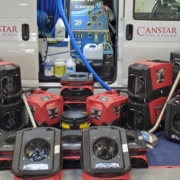The Dry Standard; An Investment in Your Health, Safety and Property

Leaks, spills, and drain back-ups are so common, we can almost consider them inevitable. After a water loss has occurred, it is critical to inspect affected materials and begin mitigation right away. After removing standing water, many home and business owners don’t have the area professionally dried, believing that if the area feels dry, they must be in the clear. However, without the proper tools and training, it is nearly impossible to tell how much moisture is still present. Secondary water damage such as mold growth and warping can lead to further health and safety consequences.
In keeping up with the needs of our clients, Canstar Fire and Flood regularly upgrade our drying equipment and processes. Our newest batch of machines is quieter, lighter, more powerful, and highly efficient. And now, thanks to Bluetooth monitoring technology, our machines are smarter.
For 35 years, Canstar has led the pack in restorative structural drying, saving our clients time, money and headaches. The goal of restorative structural drying is to remove the water from the building as quickly as possible while maintaining the integrity of the building materials. This process is scientific, requires extensive training, and is regulated.
After extracting water with the use of our pumps and vacuums, we then move on to the drying process.
To achieve the industry dry standard, we first calculate the type and number of pieces of equipment needed. We then strategically place the equipment around each ‘chamber’.
Our specially designed industrial air movers (fans) are set up in very specific patterns in the affected areas. These machines act to speed up the evaporation process. As the water evaporates from the floors, walls, and ceilings it moves into the air. The water is then pulled out of the air, captured, and condensed by the dehumidifier. It is critical that the evaporated water be removed from the building by dehumidification otherwise the water will remain in the building materials and cause secondary damage, such as mold or rot. The abatement of mold or rot is expensive, disruptive, and potentially dangerous – please do not attempt (call us).

During the drying process, Canstar’s Water Damage Technicians monitor the affected areas while employing the science of psychrometrics to help guide their actions. Psychrometrics measures the relationship of temperature, relative humidity, specific humidity, dew point, air, and moisture movement.
Our equipment, combined with our expertise and training, has saved homeowners, business owners, and insurance partners millions in repairs from secondary water damage.
The American National Standards Institute in conjunction with the Institute of Inspection Cleaning and Restoration Certification publishes ANSI/IICRC S500-2015 Standard and Reference Guide for Professional Water Damage Restoration. We encourage you to learn more by visiting www.iicrc.org
For a conversation about the importance of restorative structural drying, or to arrange for an in-depth lunch and learn session, please call or send me an email.
Johanna Molson | Sales Manager
Cell | 604 219 4056
Email | jmolson@canstarrestorations.com
